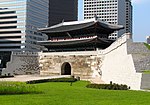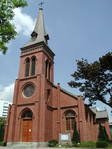Bongnae-dong
Neighbourhoods of Jung-gu, SeoulSeoul geography stubs

Bongnae-dong is a legal dong, or neighbourhood of the Jung-gu district in Seoul, South Korea and governed by its administrative dongs, Sogong-dong and Hoehyeon-dong.Global Logistics System Co., Ltd., the Jungsuck Educational Foundation, and the Korea Research Foundation for the 21st Century are in the Hanil Building in Bongnae-dong.
Excerpt from the Wikipedia article Bongnae-dong (License: CC BY-SA 3.0, Authors, Images).Bongnae-dong
Sejong-daero 5-gil, Seoul Hoehyeon-dong
Geographical coordinates (GPS) Address Nearby Places Show on map
Geographical coordinates (GPS)
| Latitude | Longitude |
|---|---|
| N 37.559 ° | E 126.972 ° |
Address
메리츠화재 봉래동3빌딩
Sejong-daero 5-gil
04512 Seoul, Hoehyeon-dong
South Korea
Open on Google Maps








